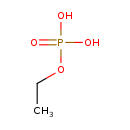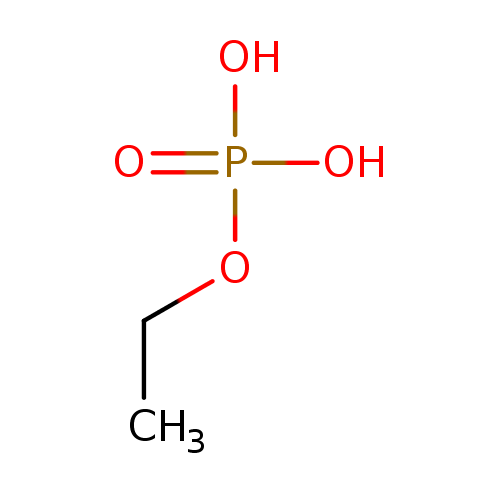|
Record Information |
|---|
| Version |
1.0 |
|---|
| Update Date |
1/22/2018 11:54:54 AM |
|---|
|
Metabolite ID | PAMDB120448 |
|---|
|
Identification |
|---|
| Name: |
ethylphosphate |
|---|
| Description: | An organophosphate oxoanion that is the dianion of ethyl phosphate arising from deprotonation of both OH groups of the phosphate. |
|---|
|
Structure |
|
|---|
| Synonyms: | - ethyl phosphate dianion
- MEP
|
|---|
|
Chemical Formula: |
C2H5O4P |
|---|
| Average Molecular Weight: |
124.033 |
|---|
| Monoisotopic Molecular
Weight: |
126.008194 |
|---|
| InChI Key: |
ZJXZSIYSNXKHEA-UHFFFAOYSA-L |
|---|
| InChI: | InChI=1S/C2H7O4P/c1-2-6-7(3,4)5/h2H2,1H3,(H2,3,4,5)/p-2 |
|---|
| CAS
number: |
78-40-0 |
|---|
| IUPAC Name: | ethyl phosphate |
|---|
|
Traditional IUPAC Name: |
ethyl dihydrogen phosphate |
|---|
| SMILES: | CCOP([O-])(=O)[O-] |
|---|
|
Chemical Taxonomy |
|---|
|
Taxonomy Description | This compound belongs to the class of organic compounds known as monoalkyl phosphates. These are organic compounds containing a phosphate group that is linked to exactly one alkyl chain. |
|---|
|
Kingdom |
Organic compounds |
|---|
| Super Class | Organic acids and derivatives |
|---|
|
Class |
Organic phosphoric acids and derivatives |
|---|
| Sub Class | Phosphate esters |
|---|
|
Direct Parent |
Monoalkyl phosphates |
|---|
| Alternative Parents |
|
|---|
| Substituents |
- Monoalkyl phosphate
- Organic oxygen compound
- Organic oxide
- Hydrocarbon derivative
- Organooxygen compound
- Aliphatic acyclic compound
|
|---|
| Molecular Framework |
Aliphatic acyclic compounds |
|---|
| External Descriptors |
|
|---|
|
Physical Properties |
|---|
| State: |
Liquid |
|---|
| Charge: | -2 |
|---|
|
Melting point: |
-56.4 °C |
|---|
| Experimental Properties: |
| Property | Value | Reference |
|---|
| Melting Point | -56.4 °C | Not Available | | Boiling Point | Not Available | Not Available | | Water Solubility | Not Available | Not Available | | LogP | 0.80 | HANSCH,C ET AL. (1995) |
|
|---|
| Predicted Properties |
|
|---|
|
Biological Properties |
|---|
| Cellular Locations: |
Not Available |
|---|
| Reactions: | |
|---|
|
Pathways: |
|
|---|
|
Spectra |
|---|
| Spectra: |
|
|---|
|
References |
|---|
| References: |
- Castrillo JI, Zeef LA, Hoyle DC, Zhang N, Hayes A, Gardner DC, Cornell MJ, Petty J, Hakes L, Wardleworth L, Rash B, Brown M, Dunn WB, Broadhurst D, O'Donoghue K, Hester SS, Dunkley TP, Hart SR, Swainston N, Li P, Gaskell SJ, Paton NW, Lilley KS, Kell DB, Oliver SG (2007)Growth control of the eukaryote cell: a systems biology study in yeast. Journal of biology 6, Pubmed: 17439666
- Morita CT, Beckman EM, Bukowski JF, Tanaka Y, Band H, Bloom BR, Golan DE, Brenner MB (1995)Direct presentation of nonpeptide prenyl pyrophosphate antigens to human gamma delta T cells. Immunity 3, Pubmed: 7584140
|
|---|
| Synthesis Reference: |
Not Available |
|---|
| Material Safety Data Sheet (MSDS) |
Not Available |
|---|
|
Links |
|---|
| External Links: |
|
|---|


